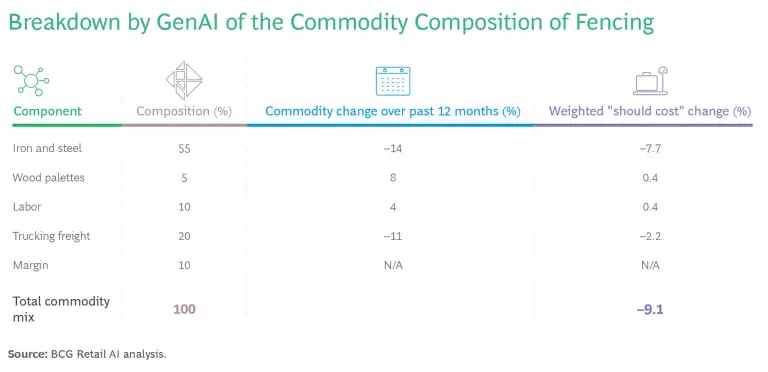This article is the first in a series on how retailers can use generative AI and advanced analytics to improve profitability.
In the face of increasing consumer price sensitivity, retailers need a full understanding of their costs, including the underlying manufacturing costs of the products they sell, in order to manage margins and compete effectively. New tools, powered by artificial intelligence, enable just that.
These new capabilities, such as BCG’s own Retail AI, put retailers across industry segments—including grocery, mass market, apparel, and home improvement—in a position to build out data sets and product compositions by leveraging AI (for analyzing existing data) and generative AI (GenAI). Retailers can obtain a clear picture of what a product should cost and how its suppliers stack up against that target. They can also track changes in costs over time to reveal the biggest opportunities for savings by vendor, category, and other parameters based on commodity price movement. Using these new tools can deliver better prices for customers and boost sales for retailers and their suppliers.
The Challenge for Retailers
The challenge is not new. Lack of transparency in the cost of many products puts a big part of pricing into the hands of suppliers and limits retailers’ ability to provide the best prices for their customers. Good data has been hard to come by, and the prices of commodity inputs, such as steel, plastic, and agricultural products, are fast moving and volatile. A full analysis of a single product's cost composition can take days, and analyzing costs for thousands of SKUs can take a team of analysts weeks to complete. And the result will be only partially accurate, either because certain data does not exist or because it’s not available. Analyses also can be out of date by the time they are completed.
The challenge is heightened now because inflation is making consumers increasingly price conscious. Retailers that don’t aggressively manage commodity-based costs risk being overpriced on the shelf, squeezing gross margins and losing out to competitors that have better pricing and cost management capabilities.
Harnessing GenAI
AI, and particularly GenAI, dramatically change the retail landscape by enhancing cost management capabilities. For the first time, retailers can:
- Create a detailed bill of materials, outlining commodity and input costs for a product or group of products that provides unprecedented visibility into commodity movements, even in volatile markets.
- Assess their products’ cost composition against market indices to determine the accurate “should cost” price.
- Compare the target cost with current supplier costs.
Users can interact with an AI-powered chatbot to modify analyses and view customized text and visual outputs based on specific prompts. They can also access real-time updates and insights, allowing them to react quickly to market shifts and capture opportunities from commodity market fluctuations, ultimately putting themselves in the best position to realize the maximum possible savings.

Consider the example of a North American retailer with a large and varied product assortment, including clothing, home improvement products, hardware and tools, and more. The retailer was able to highlight its most important SKUs by sales quantity and cost of goods and identify which were most affected by commodity price changes. The GenAI algorithm provided a breakdown of the commodities in each product and tracked its changing should-cost based on relevant indices. (See the exhibit.) For one of its biggest-selling products, the retailer was able to pinpoint commodity movements that surfaced a clear opportunity to engage its suppliers in price adjustments and growth investments in order to improve category growth and profitability.
Tools such as BCG’s Retail AI are available as software-as-a-service to integrate seamlessly with existing systems, or they can be embedded into a retailer’s own cloud solutions on its infrastructure. Automated analyses of product cost composition are easily exported and shared internally or externally so that marketing, sales, finance, and other teams can make use of the information. While some training is required, especially around data security and confidentiality, the interfaces are typically easy to use, even for nontechnical teams.
AI-enabled tools mark the beginning of a new era in retail cost transparency, providing rapid access to previously elusive information. Those that pioneer these tools will not only achieve unprecedented cost clarity but also carve out a significant competitive edge. Best-in-class retailers will foster an environment in which their teams can experiment with the new tools, bringing together human and technological capabilities to unlock new avenues of innovation and efficiency. The ability to experiment and move quickly is critical. Companies that enable their teams to explore the potential of AI will stay ahead, shaping the retail landscape and establishing defensible competitive advantage, while a bureaucratic, cautious, or incremental approach may lead to missed opportunities.









